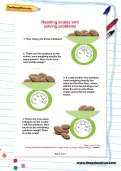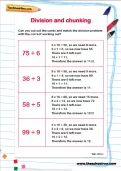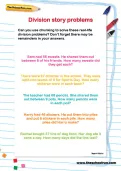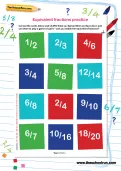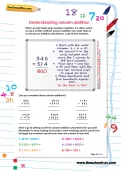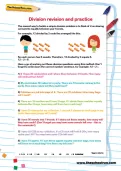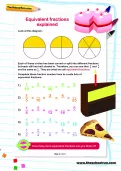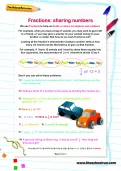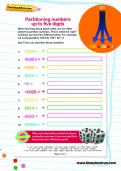On this sheet, children can cut out sweets labelled with negative and positive numbers and then put them in order. There is also a blank template for them to make their own activity.
or
Register to add to your saved resources
Already a subscriber? to view this content.
An activity involving cutting out cards and matching a division problem to the correct working out.
or
Register to add to your saved resources
Already a subscriber? to view this content.
Use this worksheet to help your child practise positive and negative numbers on a horizontal and vertical number line.
or
Register to add to your saved resources
Already a subscriber? to view this content.
Real-life word problems to help your child practise using written methods for division.
or
Register to add to your saved resources
Already a subscriber? to view this content.
Use this worksheet to practise rounding measurements of length to the nearest whole number.
or
Register to add to your saved resources
Already a subscriber? to view this content.
A matching activity for children to practice applying their knowledge of equivalent fractions.
or
Register to add to your saved resources
Already a subscriber? to view this content.
This worksheet involves real-life word problems that need to be solved using column addition. All the numbers used have three or four digits.
or
Register to add to your saved resources
Already a subscriber? to view this content.
A worksheet to encourage your child to think of equivalent fractions to match those given.
or
Register to add to your saved resources
This worksheet will give your child practice in carrying out column addition with three- and four-digit numbers.
or
Register to add to your saved resources
Already a subscriber? to view this content.
A worksheet to help children practise their knowledge of the symbols: <, > and =. It also involves practising different operations.
or
Register to add to your saved resources
Already a subscriber? to view this content.
This worksheet requires children to use their knowledge of calculation and number symbols in order to work out which number sentences are correct.
or
Register to add to your saved resources
Already a subscriber? to view this content.
Splitting big numbers can help your child learn to divide them correctly. Remind them to watch out for remainders!
or
Register to add to your saved resources
Already a subscriber? to view this content.
Help your child tackle simple division problems, practising how to translate a story problem into a number sentence.
or
Register to add to your saved resources
Already a subscriber? to view this content.
Column addition practice is much easier if your child is using a grid to help them keep the units, tens, hundreds and thousands in the right place value columns! Working through this worksheet will help them test the technique.
or
Register to add to your saved resources
Already a subscriber? to view this content.
Counting on in hops and number lines are the methods used to solve these addition calculations. This worksheet offers your child a step-by-step reminder of the technique and then lots of addition problems to practise on.
or
Register to add to your saved resources
Already a subscriber? to view this content.
An excellent KS2 worksheet created by an experienced teacher to help your child learn about finding equivalent fractions and calculating them. The pictorial representation is particularly helpful when explaining the concept to your child.
or
Register to add to your saved resources
When solving problems using a number line your child will learn to partition the number and count back. This worksheet explains the technique and offers some subtraction problems for your child to practise on.
or
Register to add to your saved resources
Fractions help us divide or share out numbers or objects. Can your child solve these simple fractions number problems by using their knowledge of numerators and denominators?
or
Register to add to your saved resources
Already a subscriber? to view this content.
Partitioning is splitting numbers into their different parts – for example, 123 is partitioned as 100 + 20 + 3. Children use partitioning in all their calculations in primary school; using their place value skills, this worksheet will help them practise partitioning numbers up to five digits long.
or
Register to add to your saved resources
Place value is one of the building blocks of primary maths education. Help your child practise identifying the value of each digit in a number with this teacher-created worksheet and boost their confidence with units, tens, hundreds, thousands and more.
or
Register to add to your saved resources
Already a subscriber? to view this content.
